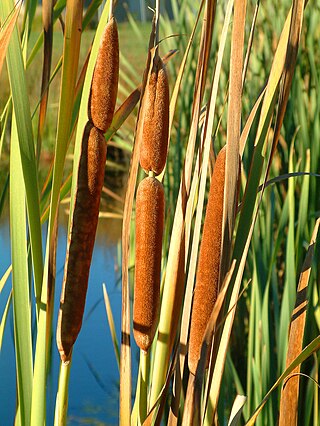Top Qs
Timeline
Chat
Perspective
Typha orientalis
Species of flowering plant From Wikipedia, the free encyclopedia
Remove ads
Typha orientalis, commonly known as bulrush, cumbungi,[2] or raupō, is a perennial herbaceous plant in the genus Typha. It is native to Australia, New Zealand, Malaysia, Indonesia, Japan, Korea, Mongolia, Myanmar, Philippines, China and the Russian Far East (Sakhalin and Primorye).[3][4]
T. orientalis is a wetland plant that grows on the edges of ponds, lakes, salt marshes, and slow flowing rivers and streams.
Remove ads
Description
Typha orientalis is a perennial herb which grows up to 3 m (9.8 ft) in height and has a rhizome of up to 40 mm (1.6 in) in diameter. The long, sausage-like flower spikes are between 300–500 mm (12–20 in) in length.[3][5]
Taxonomy
The species was first described by Carl Borivoj Presl in the Epimeliae Botanicae in 1851.[6]
Etymology
The species epithet orientalis refers to the species being found in East Asia.[5] The plant's Māori name, raupō, is a word used in different Polynesian languages to describe bulrushes.[5]
Distribution
The species is found across East Asia, Southeast Asia, Australia and New Zealand.[7] The plant was introduced to the Chatham Islands of New Zealand by Māori.[3]
Uses
Known as raupō in New Zealand,[8] the plant was quite useful to Māori. The rhizomes were cooked and eaten, while the pollen was collected and baked into cakes known as pungapunga.[9][5] The leaves were used for roofs and walls and occasionally for canoe sails,[10] as well as a material for making kites.[11] Many of the first shelters constructed for European settlers in the 19th century were made from raupō.[5]
Remove ads
Gallery
- Typha orientalis typically grows in wetlands, such as in the Brooklands Lagoon along the Styx River in Christchurch, New Zealand
- Leaves of Typha orientalis
- Flower head after bursting open to disperse seeds
- Seeds
- Pickled Typha orientalis rhizome sold in China
References
Wikiwand - on
Seamless Wikipedia browsing. On steroids.
Remove ads







